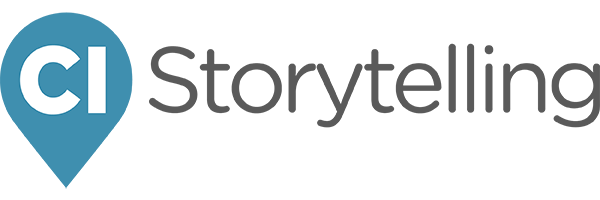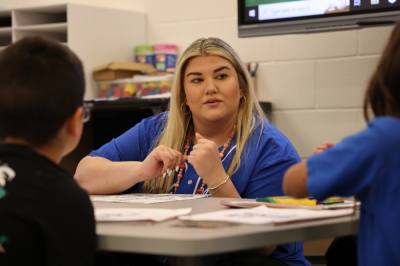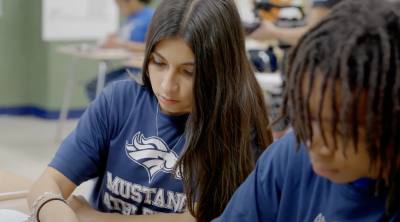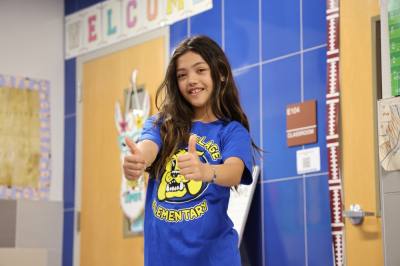In 2021, two schools in Judson ISD were selected for a Texas Education Agency grant to redesign their school models. Three years later, Park Village Blended Learning Academy and Metzger Middle School are now thriving under a blended learning model.
Explaining blended learning
While blended learning can look different at individual campuses, the core element is focused on student choice and students rotating through different stations. Students still receive face-to-face instruction, but after whole group teaching, they complete a mix of paper and digital learning. These stations can include independent learning, collaborative learning and small group learning.
The district went through an entire year of planning before this model was implemented at these two campuses.
“There was an initial planning year with the guidance of technical advisors assigned by TEA,” said Denise Jones, JISD Accountability and Innovation Director. "There were working groups at each of the campuses, and they redesigned the whole program.”
Park Village implemented new curricula, Amplify reading and Eureka math. Metzger also implemented a new curriculum and started using Carnegie Math.
An emphasis on social-emotional learning was also a key element of the grant.
Effects of social-emotional learning
Before the grant was awarded, teachers were still seeing the effects of the COVID-19 pandemic on their students in terms of their socialization skills.
“Our students are not necessarily used to being with other people and working in groups,” Park Village Principal Susaye Scott said. “Since we're doing station rotations, that's one of the things that they are required to do throughout the day.”
The elementary school students start their day with 30 minutes of a “social motion,” during which they can talk through any problems they might be having throughout the week. If it gets flagged as a deeper issue, the school involves a counselor or social worker to help resolve the issue.
“That has helped us with getting them back together and working in small groups. If they're not able to do that, we do have independent stations and they can work independently for the day if they need to, if that's what's going to fit their needs,” Scott said. “Or they can still do the same standard on the computer and work through technology. Then we also have two other stations that they can join in on, which would be either with a partner or a small group outside of just sitting with the teacher.”
Students at both campuses have responded well to combining face-to-face learning with the technology they became used to using during the pandemic.
“It blended really well. From leaving the isolation of your house in COVID to moving to a classroom and blending those two things that the kids really enjoyed,” Metzger Principal Loretta Davidson said. “I do feel the teachers enjoyed it as well. They got used to the technology and they were getting really good at it and we didn't want anybody to lose those skills. The blending was something that just went swimmingly when we moved back into the classroom.”
Program results
Not only has this new style of learning helped students adapt back to the classroom, it has also helped better prepare them for middle school and high school. Through social-emotional learning, students are adept at handling conflict not only with other students, but also other teachers as well.
Students are now able to better process their emotions and resolve conflict in a way that doesn’t come across as confrontational or result in violence.
“Being in elementary school, our students don't necessarily come with the emotional vocabulary,” Scott said. “Being a restorative justice campus, we're able to put those emotions immediately into words.”
Davidson has noticed the biggest effect in her middle school students when it comes to being vocal about what they do and don’t understand while in class.
“It's a big deal in middle school to not feel like a failure because you're stepping into secondary school,” she said. “You don't want them to leave us thinking that they're a failure, just because they didn't get this one part. If they can say, ‘If you just help me here, then I'll be able to get there.’”
The future of blended learning
With the three-year grant coming to a close in May, administrators plan to continue blended learning, as it is a part of the campus’ core pedagogy.
“We want every student in a high quality seat and blended learning can help do that,” Jones said. “We want every school to reach their potential.”
To learn more about blended learning, visit the district website.
The above story was produced by Community Impact's Senior Multi Platform Journalist Sierra Rozen with information solely provided by the local business as part of its "sponsored content" purchase through our advertising team.
Select your community
Support Us
News
- Austin Metro
-
Houston Metro
- Houston Metro Home
- Bay Area
- Bellaire | Meyerland | West University
- Conroe | Montgomery
- Cy-Fair | Jersey Village
- Cypress
- Heights | River Oaks | Montrose
- Katy | Fulshear
- Lake Houston | Humble | Kingwood
- New Caney | Porter
- Pearland | Friendswood | Manvel
- Spring | Klein
- Sugar Land | Missouri City
- The Woodlands
- Tomball | Magnolia
- Dallas | Fort Worth Metro
- San Antonio Metro











